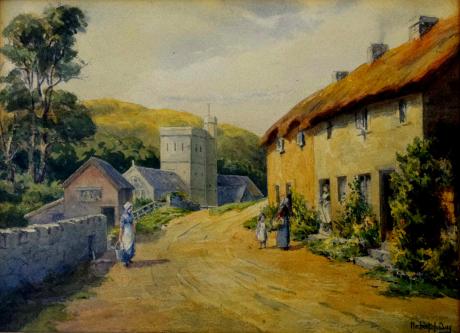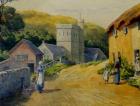Herbert J Day
Branscombe is a village in the East Devon district of the English county of Devon it was a popular with artists in the 19th and 20th Centuries such as John White, who lived in the area.
The parish covers 3,440 acres (1,390 ha). Its permanent population in 2009 was estimated at 513 by the Family Health Services Authority,. reducing to 507 at the 2011 Census. It is located within the East Devon Area of Outstanding Natural Beauty, overlooking Lyme Bay.The name of the parish is probably Celtic in origin. It is made up of two words, "Bran" and "cwm". Bran is a well established Celtic personal or tribal name that may also mean "black" or "crow black". Cwm is a topographical term still in use in English as well as modern Welsh to describe a steep-sided hollow or valley. So the name may derive from the first Celtic family or tribe to take possession of the land, probably from the Dumnonii tribe, sometime between 2000–2700 BC.
From the 17th to the 19th centuries, Branscombe was a source of hand-made lace, and Branscombe Point is a style that is still practised by lacemakers worldwide. Fishing was also a traditional industry, as well as source of food. The manufacture of flints for early guns and the cooking of limestone to make fertiliser were short-lived but important local enterprises, in the eighteenth and nineteenth centuries.
The church of Saint Winifred was originally built between 1133 and 1160 in the Norman era and enlarged in stages over the following 200 years, but there is some archaeological evidence suggesting there may have been a former Saxon building, on the site. The church contains a memorial to the Wadham family, also seated at Merryfield, Ilton, in Somerset, who succeeded the original Branscombe family as lords of the manor in the late fourteenth century. Their house at Edge Barton, in the north of the parish, still exists. When Nicholas Wadham died in 1609 part of his fortune was used to found Wadham College, Oxford.
Saint Winifred's Church is a Church of England church in Branscombe in Devon, England. The church is dedicated to Saint Winifred, a Welsh saint. It is among the oldest and most architecturally significant parish churches of Devon. It probably dates back as far as about 995, but extant records on the vicars only go back to the thirteenth century.
There is some archaeological evidence to suggest an earlier Saxon church may have occupied the site.[citation needed] The building has a traditional west-east alignment. It is built on a levelled area that can not be seen from the coast. The choice of location may have been for protection of the original Saxon church from Viking raiders. Alternatively, the church may have been placed on an earlier pre-Christian holy site. Occupying such a pagan site would have allowed the Church to both challenge paganism and benefit from any positive religious feelings associated with the site.
The church building is partly Norman and partly later medieval. The tower is central and the transepts which are later stand unusually to the west of the tower. The nave is Norman, the transepts perhaps mid 13th century. The chancel is probably 14th century, though the east window was replaced in the time of Bishop Neville (1458–64). Interesting features include the font which is 15th century and the pulpit which is a three-decker pulpit and as such almost unique in Devon. Other woodwork includes the Jacobean screen and west gallery and the altar rails of ca. 1700.



